Born from a complex mix, Vietnam’s cuisine is considered one of the best in the world
Refined or rustic, surprising, and exotic, simple, or sophisticated, Vietnamese gastronomy is a journey into travel!
If all the senses are solicited here, it is to better not only nourish the body, but also the mind. Following the subtle rules of Asian philosophy, Vietnam’s cuisine is meant to be good for body and mind, thus reaching the ancient ideal of a healthy mind in a healthy body.
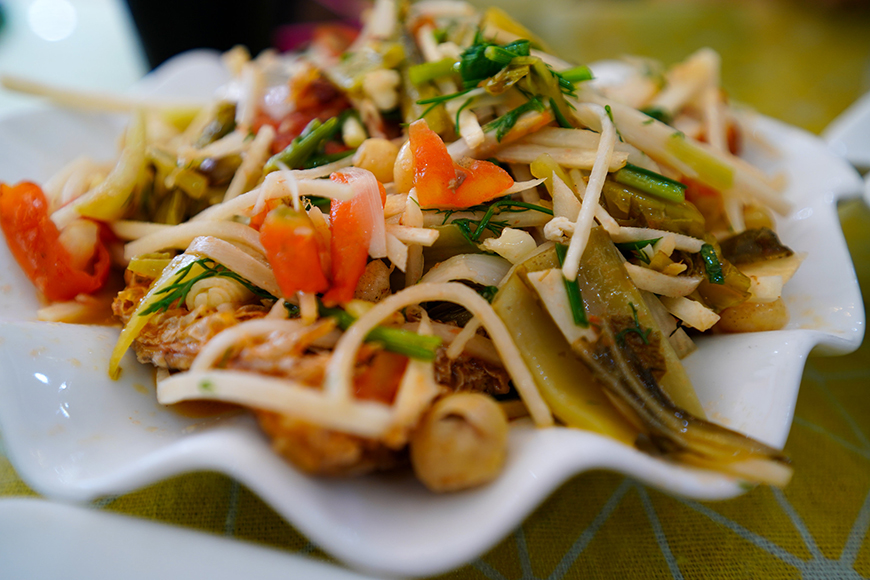
Vietnamese Cuisine is one of the best in the World © Mr Linh's adventures
Vietnamese cuisine, the spiritual basics
Long before childbirth a little late of the western concept of functional food, the
cuisine of Vietnam is part of a great whole, participating in the balance of energies present in all, obeying the rules of yin and yang. If yin is associated with «feminine» and freshness, yang with «masculine» and heat, in the kitchen we will ensure that each dish preserves the balance between one and the other. For example, if a recipe is based on seafood (yin), ginger (yang) will be added to enhance the taste and balance the subtle energies.
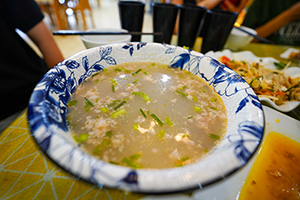 |
| Delicious Dishes from Vietnam © Mr Linh's adventure |
We will see later that the
gastronomy of the Dragon Country was born from a fabulous mix with a strongly marked Chinese influences. But let’s say right away that in the flavors and in some cooking techniques, but above all, in the symbolic, spiritual dimension of cooking, China has infused in the dishes a very Confucian esotericism. This is true of the importance of the number 5 in the culture of the Country of two Deltas, including in its cuisine. In short, Buddhism sees the 5 Miseries, the 5 Abstentions or the 5 Ways of Transmigration. Others associate the 5 with the 5 elements of the Cosmos and, to be back to the kitchen, the 5 flavors (Ngu vi, in Vietnamese), which are: acid, spicy, bitter, salty and sweet. In addition, during a trip to Vietnam, you will probably taste rice in 5 colors, a typical dish of the mountainous regions of the North of the country. And finally, know that the number 5 is even found in the banal nuoc mam sauce and its 5 flavors: the salty with the fish juice, the bitter brought by the lemon zest, the acid is given by the lemon juice, as for the spicy, it is due to the pepper and the sweet to the powdered sugar. Many other recipes are based on the 5, from the simplest to the most refined.
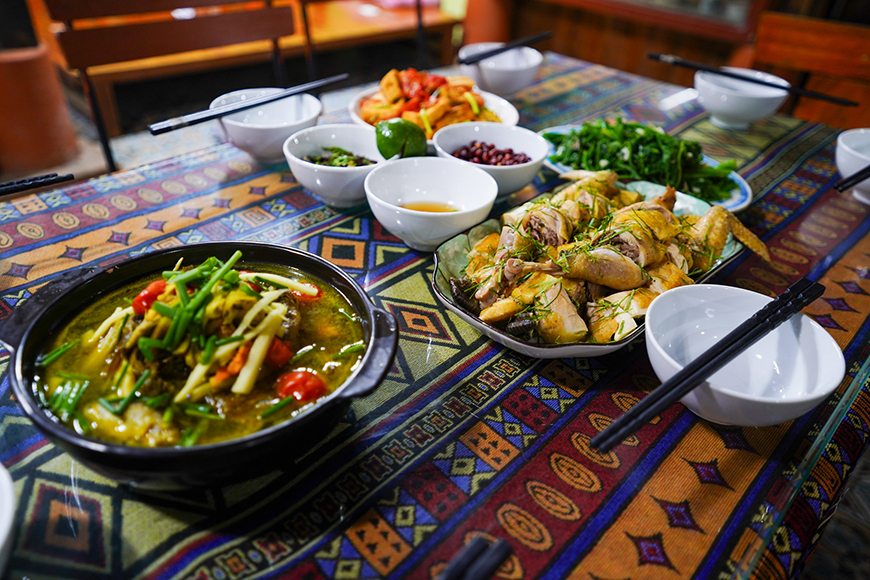
Typical dishes from North Vietnam © Mr Linh's adventures
The cuisine of Vietnam, the three regions
Backed by the Indochinese peninsula, Vietnam is a long country, which is characterized by three distinct regions as well geographically, as weather or ethnic and of course also culinary.
Renowned for a very long time, northern cuisine is a tasty getaway in the heart of a culinary tradition that knows remarkably how to combine creativity and know-how, research and rusticity, flavor, textures and colors. Witness the famous Pho, Bun Cha or Cha Ca. The Center offers rather spicy dishes, very marked by the sophistication of the imperial court. Audacity, even impertinence (the famous salted coffee was born in an alley of the former imperial city), rub shoulders with a surprising diversity of vegetarian dishes and signature dishes such as Bun Bo Hue, Mi Quang or Cao Lau, these last two typical of Hoi An. As for the southern cuisine, if it is simple, it is generous, even opulent, of a rare diversity. Often sweet, it is under the double influence of Chinese and Thai cuisine, with some borrowings in neighboring Cambodia. The other characteristic of southern cuisine is the massive use of coconut water, which gives curries, porridges and other catfish its particular and slightly oily flavor.
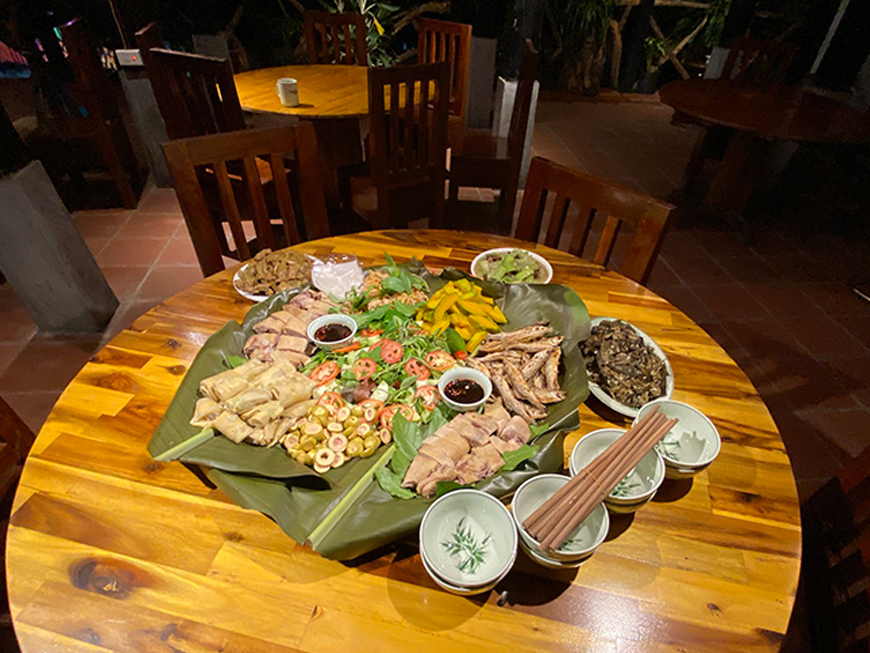
Mr Linh's Restaurant - Ba Be Lake
The culinary culture of Vietnam, a story of misgeneration
As one might expect,
Vietnamese cuisine is not just a compilation of more or less exotic recipes (each of the 54 ethnic groups making up the Vietnamese people has its own specialty…), it also reflects historical, cultural, political, even spiritual, times crossed. Between turbulent history and geography with strong contrasts, the
cuisine of Vietnam is not only a cookbook but also historybook. After nearly 1,000 years of Chinese rule, the North saw the birth of the first Vietnamese state. However, it is the Chinese who will bring the chopsticks, some recipes and ingredients (especially stir fries and noodle soups), as well as some cooking techniques (hello wok!). Freeing itself from the Middle Kingdom, Vietnam will head further south, annexing the lands of a declining Champa empire. As this was not done in one day, Vietnam had time to incorporate elements of Cham cuisine, with Indian influences and turned to the sea. This explains the taste of the inhabitants of the Centre – and in particular those of Hue – for seafood, compared to those of the North or the South. And we must not forget that in the 17th, Hoi An was a flourishing maritime counter, which saw saffron and cinnamon, two other markers of a cuisine that soaks flavors elsewhere.
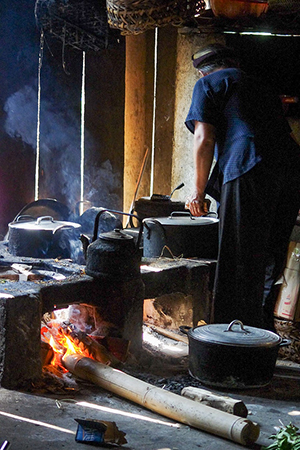 |
| Traditional cook © Mr Linh's adventure |
Speaking of Hue, under the Nguyen dynasty, the cuisine follows the particularly rigid codes of Confucianism, where behavior and etiquette have as much value – if not more – than flavors and aromas.
As for the South, the languid lands of the Mekong Delta will see a swarm of adventurers, some with overflowing and very imaginative culinary creativity. It is not for nothing that the South Delta is said Mien Tay, in Vietnamese, which means Far West.
And finally, how not to mention the French influence in
Vietnamese cuisine! French colonization, which began with the arrival of missionaries in the 18th century and only ended in 1954, had a lasting effect on the country, people, architecture, land and flavors. Some ingredients, some recipes, typically of French origin, are now part of the
gastronomic landscape of Vietnam. It must be said that the settlers quickly missed their favorite products and therefore began to import in Vietnam (but also throughout French Indochina), potatoes, onions, carrots, asparagus and other broccoli. Not to mention the unstoppable Vache qui Rit cheese (Laughing Cow cheese) and of course the baguette, which the deliciously famous Banh Mi pays today a high in flavors tribute. It is also to the French settlers that we owe the importation of beef. Before, we only knew chicken, pork, goat or buffalo. This meat is now in the bowl of Pho or in the Bo Kho, a stew finally quite close to the beef bourguignon, not to mention the Bo Luc Lac, which can be found on the tables of Cambodia. Another contribution of the French settlers: coffee and beer, two drinks that have become institutions today and one of the cultural features of the S-shaped Country.
If this article has whetted your appetite, with the next, we will go to the kitchen to discover the cuisine of the three regions of Vietnam.
►
What to eat in North Vietnam?
►
What to eat in Central Vietnam?
►
What to eat in South Vietnam?